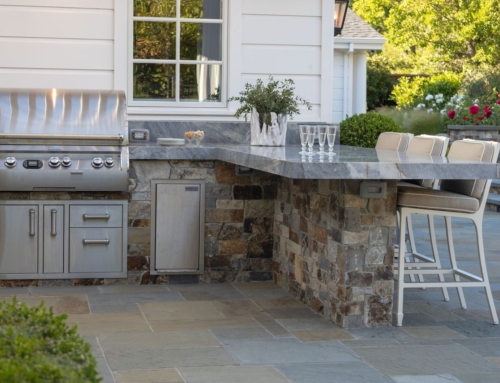HOME-GROWN GROCERIES
If you haven’t grown your own food before, it’s the perfect time to start. We feel it’s one of those things that is simple to learn but can take a lifetime to master. We aren’t masters yet by any means, but we do learn more each year, and since we remember how it was when we first started gardening, we totally know how it is to start anew. Try building a DIY home-grown vegetable garden with some of these ideas.
Courage to Create
Growing fruits and vegetables takes persistence and practice, and starting a new garden (like starting anything new) takes courage! Just remember that in return for your efforts, you’ll be rewarded with some of the most delicious, fresh and healthy food you can eat. A new garden doesn’t have to be fancy. If you have a sunny spot and a water source, you’ve basically got what you need! For a casual, temporary vegetable garden, seek out an empty part of the yard and start digging or building some small raised beds, or cluster some pots on your patio for a mini-garden. If you are planting something more permanent, such as fruit trees or grapes, our only design advice is this: Make sure you are placing them where you imagine you will still want them to be in 5 – 10 years. If you’d like a new patio one day down the line, do your best to make sure you won’t have to lose established plants that you’ve come to love.
Start Small
No one said you had to start growing everything all at once. In fact, if anyone says anything about your new garden that isn’t totally admiring, you can send them straight to us and we’ll tell them what’s what. Some of our favorite gardens over the years have been tiny – in pots, in hanging baskets, even in old rusty wheelbarrows! Many garden favorites do great in containers, including lettuces, arugula, spinach, strawberries, radishes, carrots, peas, tomatoes, and nearly all herbs. For successful tomatoes, make sure to give at least an 18” soil depth. Do the same for larger varieties of carrots to prevent them from being stunted. When growing in pots, make sure to fertilize regularly, since your plants can’t go searching very far for nutrients once the soil is depleted.
…Or Go Bigger
If you’ve got a little more space and time on your hands, start a bigger garden that will provide a large percentage of your fresh food for the year! California has an incredibly long grow season, which is why we supply vegetables and fruit for markets across America. It’s just as possible to grow in your own backyard much of what you and your family eat, Victory-Garden style. For a great resource on what to plant when, visit the Bay Area Planting Calendar.
If you live in an urban area and you’d like to put a vegetable garden straight in the ground, a lead test is easy and not a bad idea. Pick one up from your local hardware store or order online. Raised beds are a simple solution if you have any concerns about your soil’s safety, or if you simply like the look and ease of maintenance. Raised beds should be at least 18” deep and can be made of wood, metal (horse troughs with holes punched in them are popular) or of more-permanent cinderblock, stone, or brick.
Seeds or Starts?
When you go to buy the plants for your new vegetable garden, you are faced with a question – Buy plant “starts” or grow from seed? The decision is up to you, but certain things are harder to start from seed than others, and some can only be started from seed… Tricky. Here, in our experience, are the most finicky ones and how we would suggest buying them:
Only From Seed:
Carrots
Parsnips
Radishes
Turnips
Only From Starts or Tubers/Bulbs/Roots:
Artichoke
Asparagus (root)
Basil
Garlic (bulb)
Lavender
Onion (bulb)
Potatoes (tuber)
Strawberries
Sweet Potato (tuber)
Everything else is open to experiment (and if you really want to try to grow basil from seed, we suggest starting it on a sunny windowsill indoors. Good luck!) When planting your garden, keep in mind that flowers are also important. While it may sound frivolous, planting flowers that attract pollinators can actually increase your garden’s production enormously. Some of our favorites include:
Alyssum
Bee Balm (for large spaces, not great in pots)
Borage (for large spaces, not great in pots)
Calendula (also medicinal)
Catmint
Cosmos
Marigold
Salvias (flowering)
Teucrium (AKA Germander)
Yarrow (also medicinal, not great in pots)
Add Herbs
The use of herbs as medicine is increasing in popularity in America, and for good reason. While they may have been remedies our grandparents used, common herbs have properties that are just as effective today. Even the easy-to-grow oregano, sage, thyme and peppermint are powerful immune boosters and health aids (not to mention great to cook with!) Mullein, an herb often thought of as a weed, becomes a remarkably effective lung tonic when the dried leaves are made into tea. For home-grown medicinal herb info, take a look at this doctor-reviewed article and consider starting some of these herbs in your garden! Plus, some herbs are great additions to backyard cocktails or mocktails!
Happy Gardening ~
To our current and future clients: Montgomery Robbins is dedicated to your outdoor living and growing potential. Because we have the privilege of working remotely, we continue to offer all of our Design, Architecture and Master Planning services, so you can be ready to make your projects into reality when that time comes. Contact us anytime. We love hearing from you!











